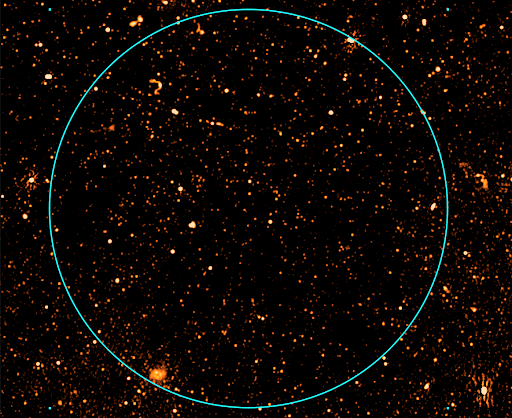Computer Picks a Mysterious Radio Object

A new generation of power radio telescope arrays is in the early stages of generating pictures of 10s of millions of radio sources in the sky. Many of these exotic giant galaxies with so-called “supermassive” black holes at the centers, with masses a billion times that of the sun. These often emit powerful jets of material from around the black hole, which are seen by radio telescopes. They are studied using giant arrays of radio telescopes in the U.S., Europe, India, which are now being joined by powerful new facilities in Australia and South Africa.
MIfA Professor Emeritus Lawrence Rudnick served as one of the lead investigators of a project to study these unusual objects using the MeerKAT array of radio telescopes in the Karoo region of the Northern Cape in South Africa. The array is operated by the South African Radio Astronomy Observatory, and is a collection of 64 telescopes, each 13.5m (44 feet) in diameter. A picture of the array, and one of the radio images from it, is shown in the figure below. The overall project was led by Kenda Knowles, from the University of KwaZulu-Natal, and is described in this article in the journal Astronomy and Astrophysics.
Because there are so many objects in these radio photographs, finding the most interesting ones is a real challenge. Astronomers are turning more frequently to automated algorithms to help them sort through the cornucopia. One of these techniques, called Astronomaly, was developed by Michelle Lochner, at the University of the Western Cape, and her colleagues. Using Astronomaly, Lochner, Rudnick, and Knowles, along with colleagues Ian Heywood of the University of Oxford, and Stas Shabala, of the University of Tasmania, identified the curious ring-like object they called SAURON, which is described here in the Monthly Notices of the Royal Astronomical Society.


SAURON appears to be one of a new class of objects called “Odd Radio Circles,” or ORCs, whose origins are still a mystery. Some astronomers think they are simply normal radio galaxies which are seen from an unusual angle, nearly head on. Others think they represent a new type of massive explosion resulting from material rapidly falling onto a supermassive black hole, with a mass of over a billion times the mass of the Sun, in the center of the galaxy. The unusual aspect of SAURON are the four bright patches along the ring, which suggested to the researchers that they might be two pairs of jets from two supermassive black holes near the center. One other unusual object was recently seen to have a similar origin. If this scenario is correct, then the two supermassive black holes could be on their way to merging, creating an enormous blast of energy, and radio emission, and even ripples in the fabric of space-time, known as gravitational waves. Followup observations will help sort out whether this, or some more mundane origin, is responsible for this computer-picked beauty.